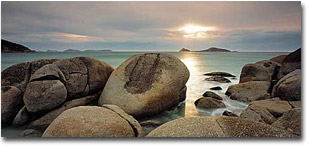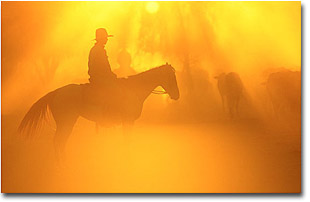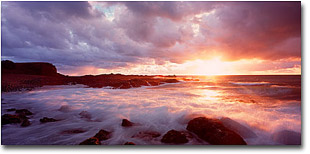The 'Ethics' of using Filters
Text and photography copyright Nick Rains. All rights reserved.
How many photographers, when showing off their latest work with glorious, rich colours, have felt slightly deflated when asked the question "So...what filter did you use for that?"
 Having opened a new gallery in July of 2002, I am getting asked this question a lot and, whilst at first I cringed, it dawned on me after a while that the public perceptions of photography are quite different for my own and that this was a valid concern from the customer's point of view.
Having opened a new gallery in July of 2002, I am getting asked this question a lot and, whilst at first I cringed, it dawned on me after a while that the public perceptions of photography are quite different for my own and that this was a valid concern from the customer's point of view.
Many of my images of Australia use strong colours for their main impact and people used to seeing dull prints of their own holiday snaps have difficulty accepting this rich colour as 'real' or 'accurate'. They know that filters exist, and may have even used them, so the natural assumption is that filters were used and that the colours are in fact slightly suspect.
Unlike painting, landscape photography is still seen as essentially a true representation of "reality". Anything that is (seemingly) faked takes away any perceived value in the work and the viewer feels deceived in subtle way. This will always be the strength and weakness of photography and that is why the use of 'filters' can be seen by the public as in some way 'cheating'.
'Filters' is of course a very broad term. I am pretty sure that when I get asked that question, what I am really being asked is "Did you add the colour using a filter or is it real?"
To which my answer is 'No, I do not use coloured effects filters, what you see is the colour shown to me by Mother Nature". That said, I will always add that I do use a polarizing filter occasionally, and this is seen as somehow acceptable
 - don't ask me why! Of course, I DO use other types of filters, just not in the way that people think or for the reasons they imagine.
- don't ask me why! Of course, I DO use other types of filters, just not in the way that people think or for the reasons they imagine.
Michael Reichmann (www.luminous-landscape.com) recently wrote an article on Digital Blending where he discussed the use of ND Grads. These are filters, but are not used for colour changes, just for contrast control. I cannot live without my set of grads; they are the secret behind some of my best images.
This then is the crucial point - filters are a perfectly valid tool and are used to overcome the technical limitations of film. Even coloured ones like 81c warm-ups fall into this category.
Photography is really the art of optical illusion. All prints are an illusion on some level; how can ink on a flat piece of paper evoke the majesty of a spectacular dawn?
The human eye is a very powerful and sophisticated sensing device and it works almost nothing like film. The software processing of the visual cortex makes Photoshop look like a 1980's calculator in comparison and it is here that the differences between 'seeing' and 'recording' are most marked.
We do not really 'record' a scene by projecting a sharp image on to a light sensitive plane like a lens, camera and film do. We are aware of a scene by using a combination of scanning and memory. By this I mean that we are really only 'looking' at a very small part of our field of vision - the rest is peripheral vision which is hazy at best., Try looking at a point a couple of inches away from this sentence and reading it becomes impossible.
We assemble scenes in our mind by continuously scanning with rapid eye movements and holding what we have sensed in our memory - a bit like RAM. Our mental software assembles the scene and we feel as though we are 'seeing' the whole subject at once. I guess itís a bit like real-time stitching software continuously and unconsciously operating behind one's eyes.
This has lots of consequences for photographers but I will stick to the use of filters for now.
It is well known that the eye can handle a lot more contrast than film - and I mean a lot more, thousands of times more in fact. This is due to the mental 'software' creating an image in our minds as well as the extended sensitivity of our retinas. Film can handle a ratio of less than 1:1000 in one exposure whereas we can 'see' a scene with a ratio of 1:10000 or more quite comfortably.
 Put simply, graduated grey filters allow us to create a photograph that 'looks' more like what we actually saw at the time - this is by no means cheating or in any way lessens the validity of the image.
Put simply, graduated grey filters allow us to create a photograph that 'looks' more like what we actually saw at the time - this is by no means cheating or in any way lessens the validity of the image.
The same goes for warming filters. The colour temperature of natural light varies enormously, whilst the film is fixed in its colour sensitivity. Warming filters are used to again overcome film's technical limitations, not to 'cheat'.
At the end of the day, we are trying to produce a coloured piece of paper, which holds all the information that our eye experienced in real life. This is clearly impossible.
The only way to produce a satisfying print is to be fully aware of how we 'see' real life and how this differs vastly from how film records it. We must then use whatever techniques are necessary to create a subtle illusion, which the mind accepts as 'real'.
All photographs are illusions after all. Filters are just part of the magic woven by a skilled photographer to share his or her memories and experiences of the wonders of nature.
About the images...
Whisky Bay, Victoria - Ebony RSW45, 58mm lens, Fuji 100F, 8 seconds at f/F22, 2-stop grad grey filter to stop the sky washing out.
Cattle muster in the Kimberley - 400/2.8 lens on EOS5. Fuji 100F, 1/500 at f/4. No filters here, but true colour due to backlit early morning dust and a bit of flare in the lens.
Lennox Head NSW - Silvestri SLV, 58mm lens, Fuji 100F, 1/4 second at f/16, 3-stop grad grey.
Editor's Note - Nick Rains is an Australian landscape photographer runs a gallery of his work in Brisbane. Be sure to visit his web site at www.rainspirit.com.au.
Nick Rains - NPN 1005
Comments on NPN landscape photography articles? Send them to the editor.


| 


